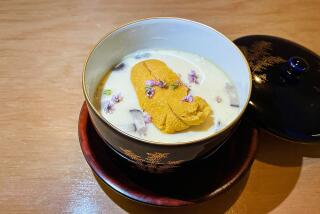Hips and Haws
- Share via
As most of us know, two of the most concentrated sources of Vitamin C are rose hips and acerola, rose hips being the fruit of the rose plant, which develops after the petals fall. Roses belong to the same family as apples, and a rose hip does look kind of like a pathetically small apple. It’s disappointing to taste--high in acid, naturally, because of all that Vitamin C. Still, people often make tea and jelly out of rose hips, and occasionally (with a lot of sugar) pies and puddings.
But what about acerola? It’s the fruit of Crataegus azarolus, a tree native to the eastern Mediterranean. C. azarolus is also a member of the same family as the apple, which sort of makes you wonder where apples were hiding when all the Vitamin C was being handed out.
The acerola fruit consists of three to five largish seeds surrounded by a pitifully meager and, of course, sour flesh. The name acerola comes, by way of Spanish, from Arabic. Not very surprisingly, the Arabic name al-zu’ru^r derives from a root meaning “to be sparse” and has the second meaning “stingy and peevish.” Acerola has rarely entered into cooking, but it’s sometimes eaten, particularly when overripe, and it’s generally understood that acerola is good for colds.
The genus Crataegus already has a good English name, hawthorn, so why aren’t we calling it by a name derived from that? Well, the fruit of the hawthorn is properly called a haw. “Contains rose hips and haws”? Not likely.
More to Read
Eat your way across L.A.
Get our weekly Tasting Notes newsletter for reviews, news and more.
You may occasionally receive promotional content from the Los Angeles Times.










